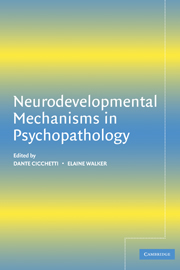Book contents
- Frontmatter
- Contents
- List of Contributors
- Preface
- NEURODEVELOPMENTAL MECHANISMS IN PSYCHOPATHOLOGY
- Part One Basic Mechanisms in Prenatal, Perinatal, and Postnatal Neurodevelopmental Processes and Their Associations with High-Risk Conditions and Adult Mental Disorders
- 1 Principles of Neurobehavioral Teratology
- 2 The Neurodevelopmental Consequences of Very Preterm Birth: Brain Plasticity and Its Limits
- 3 Neurodevelopment During Adolescence
- 5 Prenatal Risk Factors for Schizophrenia
- 5 Obstetric Complications and Neurodevelopmental Mechanisms in Schizophrenia
- 6 Maternal Influences on Prenatal Neural Development Contributing to Schizophrenia
- Part Two Animal Models of Neurodevelopment and Psychopathology
- Part Three Models of the Nature of Genetic and Environmental Influences on the Developmental Course of Psychopathology
- Part Four The Neurodevelopmental Course of Illustrative High-Risk Conditions and Mental Disorders
- Index
- References
3 - Neurodevelopment During Adolescence
Published online by Cambridge University Press: 10 August 2009
- Frontmatter
- Contents
- List of Contributors
- Preface
- NEURODEVELOPMENTAL MECHANISMS IN PSYCHOPATHOLOGY
- Part One Basic Mechanisms in Prenatal, Perinatal, and Postnatal Neurodevelopmental Processes and Their Associations with High-Risk Conditions and Adult Mental Disorders
- 1 Principles of Neurobehavioral Teratology
- 2 The Neurodevelopmental Consequences of Very Preterm Birth: Brain Plasticity and Its Limits
- 3 Neurodevelopment During Adolescence
- 5 Prenatal Risk Factors for Schizophrenia
- 5 Obstetric Complications and Neurodevelopmental Mechanisms in Schizophrenia
- 6 Maternal Influences on Prenatal Neural Development Contributing to Schizophrenia
- Part Two Animal Models of Neurodevelopment and Psychopathology
- Part Three Models of the Nature of Genetic and Environmental Influences on the Developmental Course of Psychopathology
- Part Four The Neurodevelopmental Course of Illustrative High-Risk Conditions and Mental Disorders
- Index
- References
Summary
Adolescence is a time of considerable change. Adolescents undergo periods of rapid growth and emergence of secondary sexual characteristics, along with sometimes sudden changes in behavior and mood. These obvious visible signs of adolescence are mirrored by at least as dramatic internal alterations that include substantial increases in hormone release as well as notable changes in the brain. Indeed, adolescents rival newborns in the sheer magnitude of the developmental transformations occurring in their brains.
It is interesting to note that, to the extent relevant data are available, many of these neural changes – as well as certain related behavioral ramifications – are seen across adolescents of a variety of species. Thus, although we often think of adolescence as being a characteristic phase of human development, similarities across species in the neurobehavioral features of this developmental transition have led to the suggestion that certain adolescent-typical behaviors (and their neural underpinnings) may have been evolutionarily conserved. The transformations occurring in the adolescent brain may not only facilitate characteristic adolescent behaviors, but may also alter the expression of psychopathology as at-risk individuals traverse this developmental period.
DEFINITION AND TIMING OF ADOLESCENCE
Adolescence can be defined as the gradual transformation from youth/dependency to adulthood/independency. Adolescence is not synonymous with puberty. The physiological processes associated with the attainment of sexual maturation – puberty – occur during a relatively restricted interval within the broader adolescent period, with a timing that varies considerably among individuals.
- Type
- Chapter
- Information
- Neurodevelopmental Mechanisms in Psychopathology , pp. 62 - 83Publisher: Cambridge University PressPrint publication year: 2003
References
- 25
- Cited by

